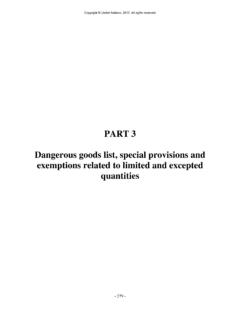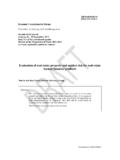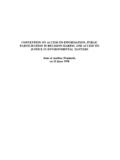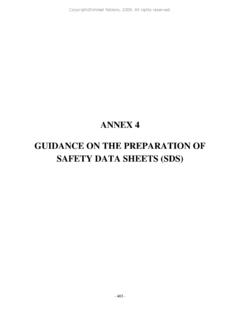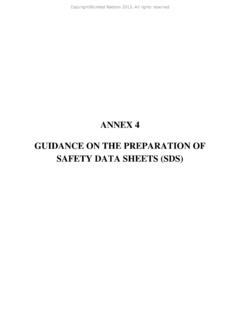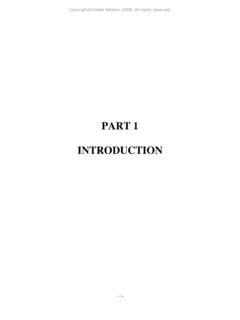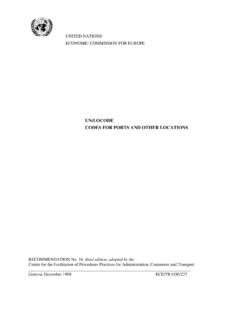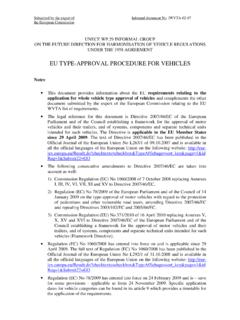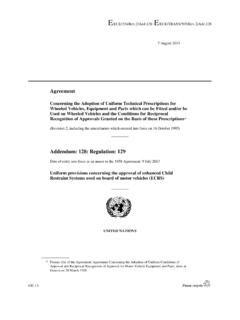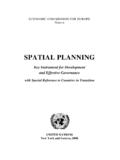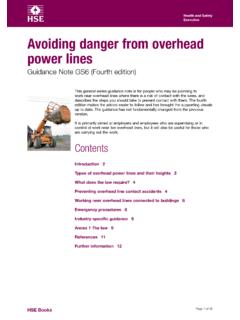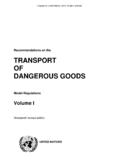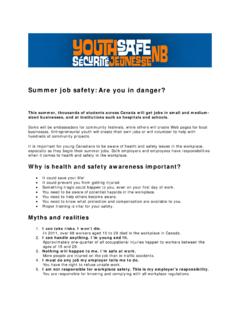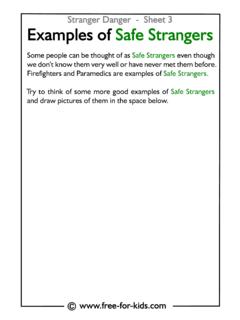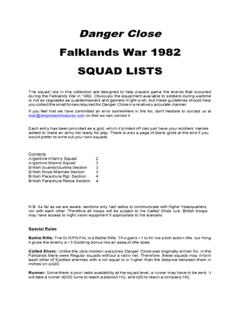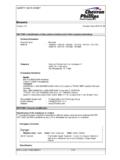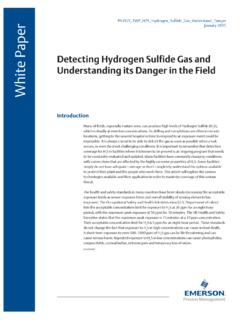Transcription of PART 3 HEALTH HAZARDS - UNECE Homepage
1 Copyright United Nations, 2007. All rights reserved part 3. HEALTH HAZARDS . - 107 - Copyright United Nations, 2007. All rights reserved Copyright United Nations, 2007. All rights reserved CHAPTER ACUTE TOXICITY. Definition Acute toxicity refers to those adverse effects occurring following oral or dermal administration of a single dose of a substance, or multiple doses given within 24 hours, or an inhalation exposure of 4 hours. Classification criteria for substances Chemicals can be allocated to one of five toxicity categories based on acute toxicity by the oral, dermal or inhalation route according to the numeric cut-off criteria as shown in the table below. Acute toxicity values are expressed as (approximate) LD50 (oral, dermal) or LC50 (inhalation) values or as acute toxicity estimates (ATE).
2 Explanatory notes are shown following Table Table : Acute toxicity hazard categories and acute toxicity estimate (ATE) values defining the respective categories Exposure route Category 1 Category 2 Category 3 Category 4 Category 5. Oral (mg/kg bodyweight) 5 50 300 2000 5000. see: Note (a). Dermal (mg/kg bodyweight) 50 200 1000 2000. see: Note (a). Gases (ppmV) 100 500 2500 20000. see: Note (a) See detailed Note (b) criteria in Vapours (mg/l) 10 20 Note (f). see: Note (a). Note (b). Note (c). Note (d). Dusts and Mists (mg/l) 5. see: Note (a). Note (b). Note (e). Note: Gases concentration are expressed in parts per million per volume (ppmV). Notes to Table : (a) The acute toxicity estimate (ATE) for the classification of a substance or ingredient in a mixture is derived using: (i) the LD50/LC50 where available, (ii) the appropriate conversion value from Table that relates to the results of a range test, or (iii) the appropriate conversion value from Table that relates to a classification category.
3 - 109 - Copyright United Nations, 2007. All rights reserved (b) Inhalation cut-off values in the table are based on 4 hour testing exposures. Conversion of existing inhalation toxicity data which has been generated according to 1 hour exposures should be by dividing by a factor of 2 for gases and vapours and 4 for dusts and mists;. (c) It is recognized that saturated vapour concentration may be used as an additional element by some regulatory systems to provide for specific HEALTH and safety protection. ( UN Recommendations for the Transport of Dangerous Goods);. (d) For some chemicals the test atmosphere will not just be a vapour but will consist of a mixture of liquid and vapour phases. For other chemicals the test atmosphere may consist of a vapour which is near the gaseous phase.
4 In these latter cases, classification should be based on ppmV as follows: Category 1 (100 ppmV), Category 2 (500 ppmV), Category 3 (2500 ppmV), Category 4. (20000 ppmV). The terms dust , mist and vapour are defined as follows: (i) Dust: solid particles of a substance or mixture suspended in a gas (usually air);. (ii) Mist: liquid droplets of a substance or mixture suspended in a gas (usually air);. (iii) Vapour: the gaseous form of a substance or mixture released from its liquid or solid state. Dust is generally formed by mechanical processes. Mist is generally formed by condensation of supersatured vapours or by physical shearing of liquids. Dusts and mists generally have sizes ranging from < 1 to about 100 m;. (e) The values for dusts and mists should be reviewed to adapt to any future changes to OECD Test Guidelines with respect to technical limitation in generating, maintaining and measuring dust and mist concentrations in respirable form.
5 (f) Criteria for Category 5 are intended to enable the identification of substances which are of relatively low acute toxicity hazard but which under certain circumstances may present a danger to vulnerable populations. These substances are anticipated to have an oral or dermal LD50 in the range of 2000-5000 mg/kg bodyweight and equivalent doses for inhalation. The specific criteria for Category 5 are: (i) The substance is classified in this Category if reliable evidence is already available that indicates the LD50 (or LC50) to be in the range of Category 5 values or other animal studies or toxic effects in humans indicate a concern for human HEALTH of an acute nature. (ii) The substance is classified in this Category, through extrapolation, estimation or measurement of data, if assignment to a more hazardous category is not warranted, and: - reliable information is available indicating significant toxic effects in humans; or - any mortality is observed when tested up to Category 4 values by the oral, inhalation, or dermal routes; or - where expert judgement confirms significant clinical signs of toxicity, when tested up to Category 4 values, except for diarrhoea, piloerection or an ungroomed appearance; or - where expert judgement confirms reliable information indicating the potential for significant acute effects from other animal studies.
6 Recognizing the need to protect animal welfare, testing in animals in Category 5 ranges is discouraged and should only be considered when there is a strong likelihood that results of such a test would have a direct relevance for protecting human HEALTH . - 110 - Copyright United Nations, 2007. All rights reserved The harmonized classification system for acute toxicity has been developed in such a way as to accommodate the needs of existing systems. A basic principle set by the IOMC Coordinating Group/Harmonization of Chemical Classification Systems (CG/HCCS) is that harmonization means establishing a common and coherent basis for chemical hazard classification and communication from which the appropriate elements relevant to means of transport, consumer, worker and environment protection can be selected.
7 To that end, five categories have been included in the acute toxicity scheme. The preferred test species for evaluation of acute toxicity by the oral and inhalation routes is the rat, while the rat or rabbit are preferred for evaluation of acute dermal toxicity. Test data already generated for the classification of chemicals under existing systems should be accepted when reclassifying these chemicals under the harmonized system. When experimental data for acute toxicity are available in several animal species, scientific judgement should be used in selecting the most appropriate LD50 value from among valid, well-performed tests. Category 1, the highest toxicity category, has cut-off values (see Table ) currently used primarily by the transport sector for classification for packing groups.
8 Category 5 is for chemicals which are of relatively low acute toxicity but which, under certain circumstances, may pose a hazard to vulnerable populations. Criteria for identifying substances in Category 5 are provided in addition to the table. These substances are anticipated to have an oral or dermal LD50 value in the range 2000 - 5000 mg/kg bodyweight and equivalent doses for inhalation exposure1. In light of animal welfare considerations, testing in animals in Category 5 ranges is discouraged and should only be considered when there is a strong likelihood that results of such testing would have a direct relevance to the protection of human HEALTH . Specific considerations for inhalation toxicity Values for inhalation toxicity are based on 4 hours tests in laboratory animals.
9 When experimental values are taken from tests using a 1 hour exposure, they can be converted to a 4 hour equivalent by dividing the 1 hour value by a factor of 2 for gases and vapours and 4 for dusts and mists. Units for inhalation toxicity are a function of the form of the inhaled material. Values for dusts and mists are expressed in mg/l. Values for gases are expressed in ppmV. Acknowledging the difficulties in testing vapours, some of which consist of mixtures of liquid and vapour phases, the table provides values in units of mg/l. However, for those vapours which are near the gaseous phase, classification should be based on ppmV. As inhalation test methods are updated, the OECD and other test guideline programs will need to define vapours in relation to mists for greater clarity.
10 Vapour inhalation values are intended for use in classification of acute toxicity for all sectors. It is also recognized that the saturated vapour concentration of a chemical is used by the transport sector as an additional element in classifying chemicals for packing groups. Of particular importance is the use of well articulated values in the high toxicity categories for dusts and mists. Inhaled particles between 1 and 4 microns mean mass aerodynamic diameter (MMAD). will deposit in all regions of the rat respiratory tract. This particle size range corresponds to a maximum dose of about 2 mg/l. In order to achieve applicability of animal experiments to human exposure, dusts and mists would ideally be tested in this range in rats. The cut-off values in the table for dusts and mists allow clear distinctions to be made for materials with a wide range of toxicities measured under varying test conditions.
